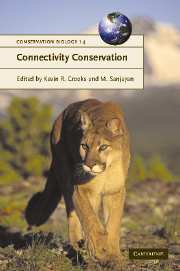Book contents
- Frontmatter
- Contents
- List of contributors
- Acknowledgements
- 1 Connectivity conservation: maintaining connections for nature
- PART I Approaches to connectivity research
- PART II Assessing connectivity
- PART III Challenges and implementation of connectivity conservation
- Introduction: Don't fence me in
- 18 Hyperconnectivity, invasive species, and the breakdown of barriers to dispersal
- 19 Disease and connectivity
- 20 Maintaining and restoring connectivity in landscapes fragmented by roads
- 21 Where to draw the line: integrating feasibility into connectivity planning
- 22 South Coast Missing Linkages: restoring connectivity to wildlands in the largest metropolitan area in the USA
- 23 Incorporating connectivity into broad-scale conservation planning
- 24 Escaping the minimalist trap: design and implementation of large-scale biodiversity corridors
- 25 The role of connectivity in Australian conservation
- 26 The future of connectivity conservation
- Index
- References
24 - Escaping the minimalist trap: design and implementation of large-scale biodiversity corridors
Published online by Cambridge University Press: 24 May 2010
- Frontmatter
- Contents
- List of contributors
- Acknowledgements
- 1 Connectivity conservation: maintaining connections for nature
- PART I Approaches to connectivity research
- PART II Assessing connectivity
- PART III Challenges and implementation of connectivity conservation
- Introduction: Don't fence me in
- 18 Hyperconnectivity, invasive species, and the breakdown of barriers to dispersal
- 19 Disease and connectivity
- 20 Maintaining and restoring connectivity in landscapes fragmented by roads
- 21 Where to draw the line: integrating feasibility into connectivity planning
- 22 South Coast Missing Linkages: restoring connectivity to wildlands in the largest metropolitan area in the USA
- 23 Incorporating connectivity into broad-scale conservation planning
- 24 Escaping the minimalist trap: design and implementation of large-scale biodiversity corridors
- 25 The role of connectivity in Australian conservation
- 26 The future of connectivity conservation
- Index
- References
Summary
INTRODUCTION
Our natural world is on the verge of a profound loss of biological diversity (Crooks and Sanjayan Chapter 1). Although the economic, cultural, and spiritual costs of this ecological impoverishment are enormous and irreversible, from a human point of view extinction's denouement appears to be “slow-motion.” This slow-motion results in a limited recognition of its urgency and the very little time we have to prevent it from occurring. As evident in this volume, the threats cut across multiple scales of ecological organization, from genes and species all the way to ecological processes. To face this complex challenge, action plans to avoid extinction must become more comprehensive, including strategies to preserve both areas and ecological and evolutionary processes, as well as those targeted to avoid the foreseeable extinction of particular threatened species.
One comprehensive regional-scale approach with great promise for effective conservation is based on the concept of “biodiversity conservation corridors,” a large-scale planning region where actions are taken to integrate representation and viability of species, ecosystems, and ecological and evolutionary processes in a scenario of explicitly defined human needs. The biodiversity conservation corridor approach shifts focus from a local to a regional scale, and represents an ambitious attempt to make protected area networks that are sufficient for species survival besides promoting an optimum allocation of resources to conserve biodiversity at the least economic cost to society (Salwasser et al. 1987).
Information
- Type
- Chapter
- Information
- Connectivity Conservation , pp. 620 - 648Publisher: Cambridge University PressPrint publication year: 2006
References
Accessibility standard: Unknown
Why this information is here
This section outlines the accessibility features of this content - including support for screen readers, full keyboard navigation and high-contrast display options. This may not be relevant for you.Accessibility Information
- 8
- Cited by
